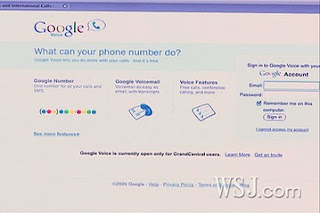
By COURTNEY BANKS,WSJ. 04/06/09
(See Correction & Amplification below)
At 10:24 p.m., a message pops up in my Gmail inbox: hey tony it's emily calling i just wanted to talk to you and i also wanted to see if you had alrighty the it's my started lunch because we need to know how many people are coming.
No, it's not a straggler that survived the spam filter: it's a voicemail message from my sister, Emily—freshly transcribed and delivered to my Gmail inbox. The "Tony" in question is me, Courtney (the cyber transcriber has particular difficulty with my first name).
I'm a bit confused about what the rest of the message means, till I click on the embedded sound file and learn that Emily wants to know if I've RSVP'd to her sorority's upcoming brunch. A few more clicks and I've responded to Emily with a text message—without fishing my cell out of my purse or dialing a number.
video
Worth It?: Google Voice
2:54
WSJ's Courtney Banks reviews Google Voice, a new phone-management service that offers voice mail transcription, international calling and a dedicated phone number for multiple phones.
This is courtesy Google Voice, a free calling and voicemail application that Google launched (to a limited group of subscribers) in mid-March. Google Voice operates under the premise that you don't need multiple telephone identities in order to have the convenience of more than one phone. Instead of calling your home phone, work number, cell, or smartphone, people can simply dial your "Google number," which then rings all or some of your phones (up to six).
You determine which callers reach which phones (i.e., if your mom calls, your cell and home phone ring; your boss goes to your Blackberry; an overly ardent admirer goes straight to voicemail). Google Voice also records, transcribes, e-mails, and archives your voice messages, lets you send texts from the Web, offers free U.S. and cheap long distance calling, and allows you to control how and when you take a call.
I spent a week testing the beta-version of Google Voice to see how well it achieves the revolution of simplicity and efficiency it promises.
The online interface is similar to Gmail's, and I can only assume that once fully launched, Voice will join its fellow Google family members—Calendar, Documents, etc.—at the top of your Gmail inbox for easy access. Once set up with my account, I entered the "real" phone numbers that I wanted to ring when people called my Google number. I added a few contacts, sent out a mass text alerting friends and family to my new Google number, and waited for the phone to ring.
[Google Voice]
A few minutes later, my phone starts to buzz; "Unknown Number" flashes on the caller ID. I answer, and a woman's voice announces: "Call from: Mom. To accept, press 1. ." You can set your preferences so that unlisted callers are asked to identify themselves before the call goes through.
Since I'm at work, I direct my mother to voicemail, but I decide to listen in first to see if her message is urgent. This feature allows your voicemail to function like your home answering machine: you can listen while the caller leaves a message, and opt to pick up. A minute later, the voicemail transcription and sound file arrive in my inbox.
The actual transcription (which is done by computer) is far from flawless—it doesn't seem like Google has assigned its most accurate automated typists to the task. Most messages I got looked something like the one above: I could make out the gist but only about 75 percent of the words were accurate. A message from my roommate Monique began, "Hey Connie it's Bernie."
Voicemail transcription is not novel, and a few other companies offer the service at a fee. To compare, I tested YouMail, which has several subscription levels ranging from $3.99 per month for basic service to $329 for a year of premium transcription. YouMail uses human transcribers, and the accuracy was near dead-on. Like Google Voice, YouMail sends the transcription as a text message straight to your phone.
Google Voice also offers free calling within the U.S., and extremely competitive rates for calls abroad (two cents a minute for much of Europe, China, and Japan). Google connects the international call and debits the cost from your Google account; your phone bill registers it as a local call. I called Vienna from my cell phone and was only charged a few pennies. I even checked my cell phone records to be sure.
Google Voice is like having your own personal switchboard operator and a dutiful but klutzy secretary. However, if you don't have phones literally dropping out of your pockets, the total switchover to Google Voice may be more trouble than it's worth. Many people, myself included, won't be too keen to take on yet another new phone number, train people to call them on it, and remember to dial the extra digits to make outgoing calls (so the Google number will register on the recipient's caller ID).
I don't deny that Google Voice has some brilliant features, many of which I'll use—I'm just skeptical whether it's brilliant enough to inspire a mass conversion.
Write to Courtney Banks at cfb2101@gmail.com











